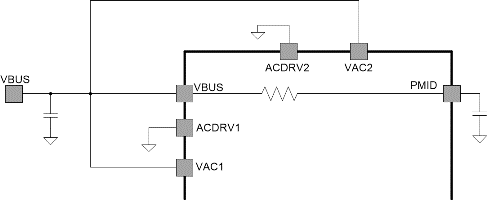SLUSDG1C June 2020 – August 2022 BQ25792
PRODUCTION DATA
- 1 Features
- 2 Applications
- 3 Description
- 4 Revision History
- 5 Device Comparison
- 6 Description (continued)
- 7 Pin Configuration and Functions
- 8 Specifications
-
9 Detailed Description
- 9.1 Overview
- 9.2 Functional Block Diagram
- 9.3
Feature Description
- 9.3.1 Device Power-On-Reset
- 9.3.2 PROG Pin Configuration
- 9.3.3 Device Power Up from Battery without Input Source
- 9.3.4 Device Power Up from Input Source
- 9.3.5 Dual-Input Power Mux
- 9.3.6 Buck-Boost Converter Operation
- 9.3.7 USB On-The-Go (OTG)
- 9.3.8 Power Path Management
- 9.3.9 Battery Charging Management
- 9.3.10 Integrated 16-Bit ADC for Monitoring
- 9.3.11 Status Outputs ( STAT, and INT)
- 9.3.12 Ship FET Control
- 9.3.13 Protections
- 9.3.14 Serial Interface
- 9.4 Device Functional Modes
- 9.5 Register Map
- 10Application and Implementation
- 11Power Supply Recommendations
- 12Layout
- 13Device and Documentation Support
- 14Mechanical, Packaging, and Orderable Information
9.3.5.2 VBUS Input Only
In this configuration, only a single input is connected to VBUS, so that no power MOSFETs are required. VAC1 and VAC2 are shorted to VBUS, and ACDRV1 and ACDRV2 are pulled down to GND, as shown in Figure 9-2. At POR, the charger detects that no ACFETs or RBFETs are present by sensing that the ACDRV1 and ACDRV2 pins are both shorted to GND and configures power mux register fields as shown in Table 9-5.
 Figure 9-2 Single Input Connected to VBUS
Directly Without ACFET-RBFET
Figure 9-2 Single Input Connected to VBUS
Directly Without ACFET-RBFETTable 9-5 Single Input Configuration
Summary
| PIN OR REGISTER FIELD | STATE |
|---|---|
| External MOSFETs | No external power mux MOSFETs. |
| VAC1 pin | Shorted to VBUS |
| VAC2 pin | Shorted to VBUS |
| ACDRV1 pin | Shorted to GND |
| ACDRV2 pin | Shorted to GND |
| ACRB1_STAT | 0 (Read Only) |
| ACRB2_STAT | 0 (Read Only) |
| DIS_ACDRV | 1 |
| EN_ACDRV1 | Locked at 0 |
| EN_ACDRV2 | Locked at 0 |